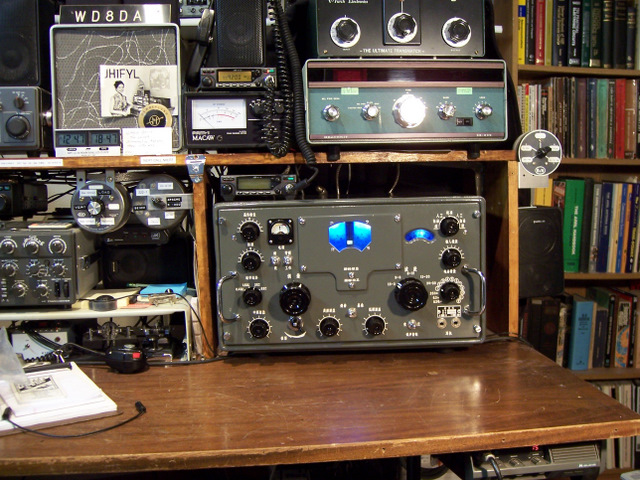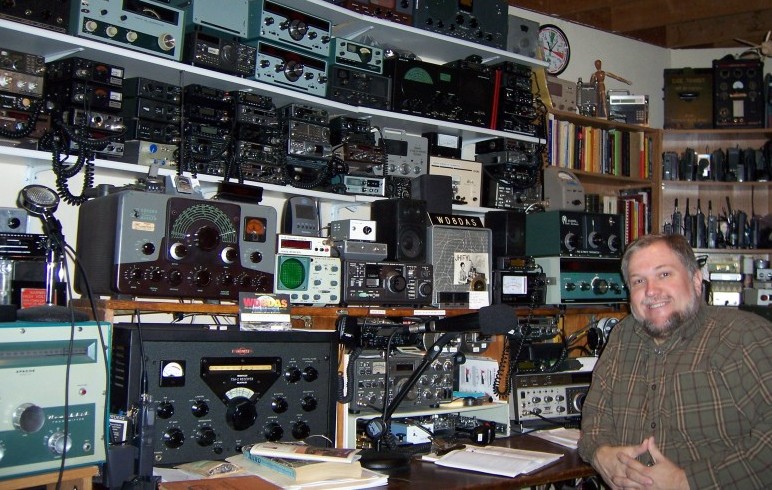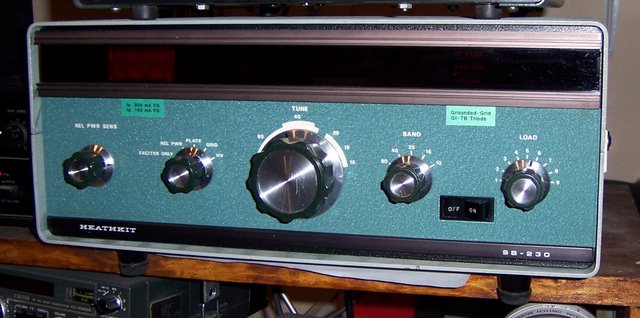| [ Home ] [ Vintage SSB Gallery ] [ AC0DN ] [ N3XXT ] [ VE3WF ] [ K0EOO ] [ WØKH ] [ W0RDX ] [ W1FIF ] [ WB2EXG ] [ K6DPZ ] [ K8GM ] [ KG8LB ] [ K8NTK ] [ WA8SAJ ] [ WD8DAS ] [ AB9MQ ] [ K9BCF ] [ K9BDR ] [ K9DXI ] [ K9EYE ] [ K9KEU ] [ K9NAM ] [ K9OA ] [ KC9AA ] [ KC9CLM ] [ KC9KOJ ] [ N9CQX ] [ N9IIF ] [ N9MS ] [ N9OEQ ] [ N9RK ] [ N9WQ ] [ NJ9V ] [ W9CAR ] [ W9GL ] [ W9GOB ] [ W9LRS ] [ W9TKO ] [ W9QI ] [ W9RAD ] [ W9RAN ] [ W9RMB ] [ W9RWS ] [ W9VFD ] [ W9WRL ] [ W9ZT ] [ WA9VRH ] [ WB9CTP ] [ WB9ECK ] [ WB9GKZ ] [ WD9JIM ] [ WJ9Y ] [ WQ9E ] |
TA-838/TT Field Phone
| Here's a photo of the vintage military field phone I used to call into the net this morning. It is the
TA-838/TT -- the last of the analog field phones. Note the straps for hanging the phone from a fence post or tree trunk. |
hello
|
Southcom SC-130 military transceiver

Here's a photo of the Southcom SC-130 military transceiver that I used on the Vintage SSB net this morning.
|
|

|
The Chinese receiver is alive and kicking. I put a three-wire cord on the power supply and gradually increased the applied voltage with a variac over a couple hours. Then I connected it to the receiver and 220 VAC. No problems - it came right up. Receiver seems quite stable drift-wise, but mechanical shocks will shift the BFO frequency significantly.
It was in pretty good alignment, but I was able to improve it - the manual and chassis band markings helped identify the proper adjustment points. I do not know any Chinese characters but I can compare the ideographs in the manual with the labels on the front panel and at least find the same symbol. What it means is another story. And there are a few, very few, recognizable English designations present, like "47k" or "C141" so that helps. It is like deciphering a mysterious code.
The purpose of some of the front panel controls are not clear to me yet. By cross-referencing values, construction, and the schematic clues I determined the three front panel gain controls: RF gain, IF gain, AF gain. I haven't yet got the AGC working as I would expect - either I don't know how to switch it on, or it isn't working right. And I have no idea yet about 3/4 of those many metering switch positions.
I traced the 1/4" audio output on the back and it comes from a 600 ohm transformer winding, so I'm using one of my medium impedance US military speakers, a brand new LS-166/U. I think the headphone jacks are 600 ohm too. There may be a low Z output on the remote control jack, not sure yet. |
|

Radio Storage |

Tempo 2020
The Henry Radio Tempo 2020 was the
successor to the very successful Tempo One transceiver. Although the Tempo
One was built for Henry by Yaesu, the 2020 was built by Uniden. It is all
solid-state except for the driver and final amplifier tubes. The receiver
has plenty of great sounding audio and is one of the few transceivers with
a variable RF attenuator control. Another unique feature of this rig is
the 100Khz band segment selector arrangement. Each band is divided into
100Khz segments which are PLL controlled. The desired segment is selected
by a front panel pushbutton.
|

Kenwood TS-130 |

Kenwood TS-180S
|

Kenwood TS-530S |

Steve WD8DAS Main Desk (Ed. note: Holy Crap!!!) |

Steve says this is a homebrew single 813 amplifier that he bought without a B-plus
power supply. It was made to try and match the Heathkit line.
|

Atlas 210x transceiver. I thought they all
covered 160 but apparently
this model does not.
|

Galaxy 300 - is a 3 band transceiver
- the predecessor to the Galaxy III (3 band transceiver) and the Galaxy V
(5 band transceiver). This is the rig that almost killed me 30 years ago.
I was 13-14 years old, fooling around one evening in my room, trying to determine why there was a tube shield on the Galaxy's 6BZ6 RF amp tube. It is located right behind the finals in the PA compartment.
At one point I got very careless. With the transceiver turned on (bad), in fact transmitting a full-power carrier (very bad), I lifted the lid and reached back in with my right hand to remove the 6BZ6's shield. Trouble is, to get to it I reached over the two 6HF5 finals and their plate caps with about 900 volts DC, plus a couple hundred watts of RF. My wrist touched the plate caps at the same time my fingers reached the tube shield, and the shocking and the burning commenced. My hand drew up in a fist, making it seemingly impossible to pull it back out. With the pain of the electric shock and RF burns I couldn't get my hand out! Fortunately I was only using one hand for this madness, and I ultimately pushed myself away with my other hand on the wooden desk. This also meant that the current had only flowed through my hand and arm, not across my chest (very good).
I had some pretty serious and painful burns on my hand and forearm. Clutching my wounded limb, I sat on my bed considering my options. I had a VERY BIG CONCERN that if I told my parents what had happened they'd stop my ham hobby dead. I was also very embarrassed to have hurt myself in such a dumb way. But I was also hurting pretty bad, and worried about the side-effects of a strong shock, so I concluded to be up-front about it. Not sure now how I would have hidden the injuries anyway. now that I think about it thirty years later.
They handled it very well, and took me to the hospital emergency room. The doctor did not understand the situation very well and was checking my feet for burns, worried about my heart, etc - and he demanded that I be kept overnight. I was admitted and put into a bed in a room with eight patients.
|


Heathkit SB230 linear |

KW Electronics KW-2000B from England. I think I used if for my
first check-in to Pat's vintage SSB net
|
|